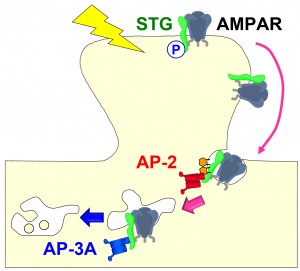Clarification transport mechanisms of AMPA receptors in nerve cells - key to learning and memory
 Long-term depression is one of synaptic plasticity (LTD; Long-Term Depression)は、By the number of AMPA receptors in dendrites decreases、Efficiency of information transfer in the synapse is the phenomenon to be reduced in the long term。But we do not know well whether the number of AMPA receptors is controlled by any mechanism。Elucidation of the mechanism is not only a better understanding of brain function、It is expected to lead to the development of the understanding and treatment of a variety of brain diseases。
Long-term depression is one of synaptic plasticity (LTD; Long-Term Depression)は、By the number of AMPA receptors in dendrites decreases、Efficiency of information transfer in the synapse is the phenomenon to be reduced in the long term。But we do not know well whether the number of AMPA receptors is controlled by any mechanism。Elucidation of the mechanism is not only a better understanding of brain function、It is expected to lead to the development of the understanding and treatment of a variety of brain diseases。
It will be transported to the cell membrane (cell surface) after present in the cell membrane "membrane protein" that is synthesized in the cell。Membrane protein receives information extracellular、It plays a function of transmitting to the cell。For example AMPA receptors will excite the nerve cells by binding to the glutamate。The amount of membrane protein present on the cell surface、Transport and from within the cell to the cell membrane、It has been precisely controlled by a balance of speed to take from the cell membrane into the cell。This latter process is generally controlled by AP-2 or AP-3A adapter protein。But whether the transport into the cell of the AMPA receptor is controlled how by the adapter protein was a mystery until this。
Matsuda Shinnanji lecturer、In this paper, a protein that binds tightly to the AMPA receptor Stargazin is、We found that it binds strongly when it is dephosphorylated with the enhancement of neural activity in the AP-2 and AP-3A。as a result、AMPA receptor -Stargazin complexes efficiently incorporate into cells、The number of AMPA receptors on the cell surface over a long period of time is reduced。Through this research、So far of the AMPA receptor that is directly linked to memory and learning was a mystery intracellular transport mechanism is now revealed for the first time。Nature CommunicationsIt became the online published in。

11/12/2013 9:07 PM | What's New